#Seymour Duncan Distortion i
Explore tagged Tumblr posts
Text
well it's going but I need more 20 grit

#boing-oposting#im doing a supremely bad job but nothing has gone so wrong it won't be playable#ignore the lines btw I'm not doing a forearm contour anymore.#mmm onboard distortion single pickup burgundy black walnut sg-o-strat#and a killswitch. should come in the mail soon. i wanna use seymour duncan distortion humbucks since it's played with effects anyways#however I'm literally spending all my money on the neck#because i don't trust anything unbranded unless i can hold it- and I can't hold it#because there's nowhere to buy guitar parts in my area
1 note
·
View note
Text
Epiphone Adam Jones 1979 Les Paul Custom officially announced
The Epiphone Adam Jones ‘non-art’ Silverburst Les Paul Custom is everything that fans wanted and now it is out today

View On WordPress
#2024#Adam Jones#Adam Jones 1979 Les Paul Custom#Art Collection#Epiphone#Epiphone Adam Jones &039;non-art&039; Silverburst Custom 2024#Epiphone ProBucker Custom humbucker#Epiphone Protector#Korin Faught#Les Paul Custom#Seymour Duncan#Seymour Duncan Distortion i#Silverburst#Sweetwater#Tool
1 note
·
View note
Text
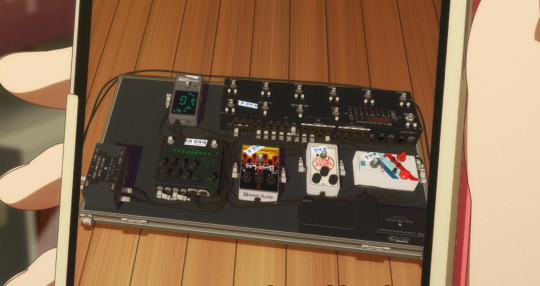
okay, let's try to identify all of the new gear in anon's brand-new-spanking signal chain, and see how much her total comes out to. values will be in both USD and JPY - not via direct currency conversion, but by prices I find online at american and japanese retailers respectively. (note that american retailers do not include tax in prices, but japanese retailers do. prices may also differ due to import/export costs.)
also thanks to @absolute-total-nonsense for helping me ID a bunch of these
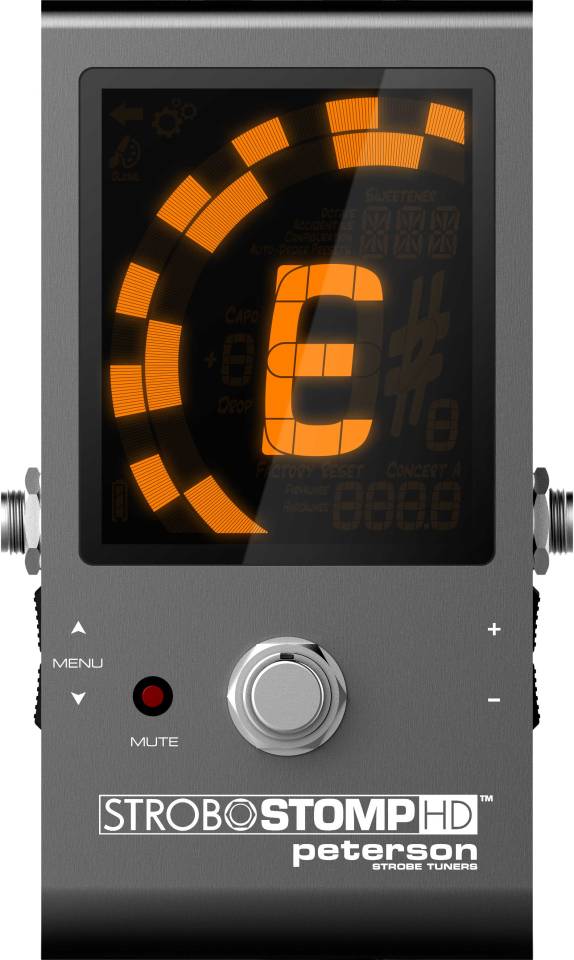
the gray pedal at the top right is very clearly a tuner, displaying note information and pitch accuracy. it very clearly resembles the peterson line of StroboStomp pedal tuners, but is closest to the Peterson StroboStomp HD Pedal Tuner (MSRP $149.00 USD / ¥28,444 JPY).

the black pedal with green text, is, thankfully, clearly labeled. it is a Seymour Duncan Andromeda Dynamic Digital Delay pedal. there's a lot going on here! it clocks in at MSRP $299.99 USD / ¥44,000 JPY.

the next pedal to the right is similarly labeled with a distinct design, and is a Boot-Leg HZM 2.0 Quattro Valvole Distortion Pedal. it's our first Japanese-manufactured pedal in the signal chain, and doesn't have an official USD MSRP, but can be found for $135.00 USD, and is sold domestically for ¥21,120 JPY.

the next pedal was a bit hard for me to make out until I got a higher-quality screencap of the pedalboard and could actually read the label, but it's a Electro-Harmonix Soul Food Distortion/Overdrive Pedal. in the states, it clocks in at $101.60 USD. I couldn't find an exact MSRP for the pedal in JPY (perhaps due to it not being formally exported, speculatively), but I found it online for ¥16,088 JPY.

the text is a bit hard to read in the screencap for the next pedal, but the tricolor design and the seymour duncan logo is plain as day. it's the Seymour Duncan Forza (tm) Overdrive. it clocks in at MSRP $179.00 USD / ¥28,600 JPY.
the next few components that tie the signal chain are all Free The Tone products.

the large box is a Free the Tone ARC-3 Audio Routing Controller. it seems to be discontinued, but had a MSRP of approximately $599.00 USD / ¥63,800 JPY.

the input to the pedalboard is a Free the Tone Signal Junction Box JB-41S, priced at $159.09 USD / ¥18,000 JPY.

finally, the power supply is a Free the Tone Power Supply PT-5D, priced at MSRP ¥30,800 JPY, and seems to be resold for $309.99 USD.
so, not including any instrument cables, ac adapters, or the physical case for the pedalboard itself, anon's brand-new pedalboard is priced at a budget of a whopping $1932.67 USD + tax, or ¥250,852 JPY! damn, girl! do you really need that many different overdrive/distortion pedals!
BONUS:


anon's mini practice amp appears to closely resemble a Danelectro Honeytone N-10 Guitar Mini Amp, though the Honeytone text is ommitted and I don't believe it's ever been manufactured in pink. it's priced at $24.99 USD / ¥5,720 JPY.
48 notes
·
View notes
Photo

BUILD COMPLETE!! I present The “Sky-Stang” Fender Japanese Mustang + DiMarzio Super Distortion bridge Humbucker. Painted a beautiful traditional Sonic Blue by Rob Broyhill (if you need painting done, he is your dude). Lastly, Sperzel locking tuners. ••• This started out as a Covid project. Sorry, I’m not paying $3000 for a Cobain cash grab. So…let’s build one! Mine has some differences here. Kurt's was an MG69 model. The back on those are contoured and the neck is smaller. But hey, an MG65 for super cheap on Marketplace seemed fair to me. I play more aggressive rock & metal so I prefer the DiMarzio Super Distortion (DP100) humbucker (which the Jaguar signature is loaded with) opposed to the Seymour Duncan JB HB (also great! My MG69 Mustang has one). Jason Racino is a wizard with guitars. He wired the Dimarzio and set up the guitar. The bridge is not fixed but it's pretty locked down. This is set up for CGCFAD drop tuning with 52-10 gauge SIT Strings .. Lastly I added Sperzel Trim-Lok 6-In-Line Tuners. The Fender stock tuners are horrible. I did this on my Jag-stang as well. Sounds mean through both Marshall and Orange Courtney Valvo
#fendermustang#kurtCobain justinDriscollPhotography charlotteNC dimarzio fenderGuitars paulCbuff canonPhotography
3 notes
·
View notes
Text
There is Joy in Simplicity: 19th century Optical Toys

A late 19th century advertisement for the Stereoscope. It advertises the ability to be “Around the World in 60 minutes” reflecting the educational quality people believed the Stereoscope to have. Source.
I have become engrossed in the world of Yo-Yos lately. This little hunk of plastic with the name Duncan painted on the side, flying through the air on a string. By itself it seems so perfectly simple, however the world of Yo-Yos is deeper than one would think. For instance, there’s several different types of Yo-Yos with their own advantages and disadvantages based on their material and shape. While a Yo-Yo may seem like a simple toy, they also demonstrate a humans ability to learn reflexes. At first, I could barely get the Yo-Yo to come back up but after weeks of continued use I can shoot a dog across the wooden floor of my mother’s kitchen. Toys in a society are truly significant, because they represent what that society wants the young to learn or what they themselves want to play with. They are a form of experimentation.
Just as the yo-yo represents a learning of reflexes, the toys of 19th century America reflect the societal obsession with illusion and vision. Granted, people of the 19th century already had stuff like dolls (which I would argue is still related to vision of the human form), wooden tops and yoyos, dominos, balls, and all other means of play, but the late 19th century sees a boom of vision-based toys. We see the kleidoskope, the thaumatrope, the phenakistoscope, the stereoscope, the zoetrope, and the praxinoscope emerge as these fun little practices in vision. The early hints of film, the basics of animation, the play of illusion all appear in this era.
These toys exist as echoes of the 19th century American societal interest in deception, vision, and representation of self. In the early 19th century, the American faced challenges of identity, the crowd, later on they faced the mass societal grief and crisis of war, the camera as a view of reality, and the concept of the showman like P.T. Barnum, going into the late years of the era we see the early hints of film come out and the concepts of reality. Throughout the 19th century we see visions-based gadgets appear as supplements to the already ongoing discussions of view. Toys like the kaleidoscope, the thaumatrope, the phenakistoscope, the stereoscope, and the zoetrope and praxinoscope all represent a growing societal interest in vision and experimentation throughout the 19th century.
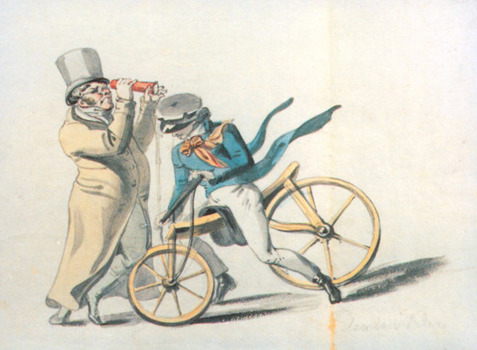
An 1818 illustration titled “Human Nonsense”, the man in the top hat is so entranced by the kaleidoscope, he doesn’t notice he’s walking directly in front of a bike. The Victorians had what Is now called a “craze” over kaleidoscopes as they allowed exploration of vision. Source.
The first optical toy to be invented in the Victorian age was the Kaleidoscope in 1816, by David Brewster, who we will see appear again. Jason Farman of Atlas Obscura describes the 19th century kaleidoscope design as, “made from a range of materials, such as tubes made of brass with embellishments of wood or leather or those cheaply made of tin. The base of the tube was typically filled with broken pieces of glass, ribbons, or other small trinkets.” When viewed from one side, the other would appear as a range of fantastical colors, patterns, and shapes. It almost immediately gained massive popularity, amongst both children and adults, scientists, artists, and industry professionals. Scientists “found it useful as a tool to visualize massive numbers” while artists and industrials used it “for patterns on china, paper, carpets, floor-cloths, and other fabrics” (Farman).
It was experimentation in the role of the eye in light, and shape, along with the illusions of beauty, or reality, when viewed close with a magnifier. Truthfully, some people felt betrayed when they found out what was inside of a kaleidoscope, R.S. Dement, a playwright, writes he was “deceived (as a child) into believing that what he saw was at least the shadow of something real and beautiful, when in truth it was only a delusion” (Farman). However, this only further intrigued some of the Victorian viewers:
These new visual tricksters fed into the fascination in the deficits of the human eye and how it could be misled. As people began understanding human vision differently because of these objects, people also began seeing the world through machines like trains, moving walkways, and steamships (Farman).
While the kaleidoscope is simplistic, it is not to be denied it is important as a starting point for the 19th century conversation on vision. A tube that presents to the viewer an illusionary range of symmetrical colors and patterns, created by broken glass, ribbons, and random scraps.

Vignette by George Cruikshank from Philosophy in Sport, 1827. Source.
The next optical toy to appear was the thaumatrope, appearing in the mid-1820s (when it was first published) by John Aryton Paris. The history of the thaumatrope is a mixed and complex mess of early 19th century scientific figures making a bet, including John Herschel (A popular astronomer), Charles Babbage (A mathematician who made the calculating engine), and David Brewster, however it stands clear as a true foundation of visual interest (Herbert). As much as I talk it up, the toy is extremely simple. It consists of a piece of cardboard with two strings on each end, with a picture on both sides (the classic example is bird on one side and a cage on the other) and when the user twists the strings fast enough the two images appear to become one (The bird appears inside of the cage). The same effect had been created by spinning a coin previously, however the thaumatrope was the first to give “the phenonium a scientific explanation and a device produced to be sold as a popular entertainment” (Gunning 499).

Bird-in-Cage Thaumatrope, the classic example and believed to be the first thaumatrope image created as an example, by Dr. Fitton. This depiction pictures the expected result of twisting the strings. Source.
While it is basic, its an extremely effective toy for teaching a core concept of the 19th century. There is flaw in the human vision, or moreso, the human vision has depths and conditions. From 1827’s Philosophy in Sport by Paris, “I will now show you that the eye also has its source of fallacy” says “Mr. Seymour” as he operates the device (501). Its simplicity allows there to be no questions about interference from the toy’s design, there is no mirror, or screen, or other window the viewer is looking at the toy at through.
“We can operate it and understand its process. But the image it produces is not fixed in space, embodied in pigment or canvas; it occurs in our perception. Yet while it may be defined as a subjective image, taking place through our individual processes of perception, it is not a fantasy or, in a psychological sense, a hallucination” (513).
There is simply vision, and the effect of the lasting image (called an afterimage) the human eye creates with the reality the user is the sole reason the illusion continues. Tom Gunning captures perfectly what the Thaumatrope meant as a foundational toy, “This device introduces to the Victorian era a new class of images simultaneously technological, optical, and perceptual” (500). It is the perfect device to start the 19th century with a magical simplicity that allows the user to experience illusion in their own hands through natural processes of the eye.
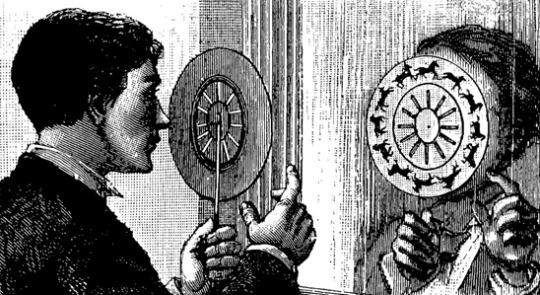
An illustration depicting a person using the phenakistoscope. Of course, it’s impossible to depict the movement accurately in a drawing. Source.
Later, in 1832, the phenakistoscope was “simultaneously invented…by Joseph Plateau in Brussels and by Simon von Stampfer in Berlin” though other concepts were in the works at the same time (“Phenakistoscopes (1833)”). The so called “parlour toy” is a cardboard disc on a handheld stick with an outer circle of images and an inner circle of slits which the viewer would look through. The “trick” of the toy is to spin it while looking through the slits into a mirror, where the images on the outer circle jump to life in animation through the distortion and the flicker of light as the disc moves. “The scanning of the slits across the reflected images kept them from simply blurring together, so that the user would see a rapid succession of images that appeared to be a single moving picture” (“A Short History of the Phenakistoscope”). Its one of the earliest forms of animation, completely using human sight as its method.
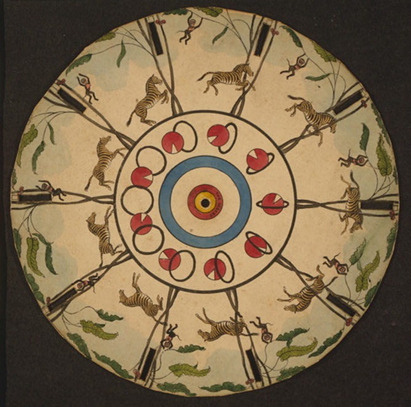
A Phenakistoscope featuring zebras and monkeys in a jungle setting, the zebras would run, and the monkeys would swing when viewed through a mirror. This particular phenakistoscope is from a competing product of the original production, “Mclean’s Optical Illusions or Magic Panorama” from 1833. This is a simplistic image, but phenakistoscopes became more complex as years went on. Source.
Like how the thaumatrope represents a flaw in human vision, the phenakistoscope fully represents the conditionality of vision. The human eye is susceptible to condition, to light, to distortion of light, to illusion. The illusion is only possible through a window, the mirror, showing the young the new concepts of the human eye as an unreliable “narrator” by itself. However, at the same time it shows it through an exciting illusion of movement. The Phenakistoscope saw mass popularity, being published under names like Fantoscope and “Magic Wheel”, leading to further visual toys being produced which would eventually overtake the simple phenakistoscope and thaumatrope. However, before we get into them let us take a quick sideroad into the world of photography.

A 1908 advertisement for a stereoscope viewer in the Pittsburgh Daily Post. It presents the stereoscope as a tool, and as entertainment. Source.
In 1838, Charles Wheatstone published a paper reporting an odd illusion he had discovered where two drawings of the same object, at slightly different perspectives, were placed next to each other the two would be fused together by the eye into a three-dimensional view of it. It is realized this is exactly how the eye functions, each eye taking its own perspective and the two images fusing together for a full three-dimensional view (Thompson). From Oliver Wendell Holme’s 1859 essay on the Stereoscope (After it gained mass popularity):
The two eyes see different pictures of the same thing, for the obvious reason that they look from points two or three inches apart. By means of these two different views of an object, the mind, as it were, feels round it and gets an idea of its solidity. We clasp an object with our eyes, as with our arms, or with our hands (Jacobi).
Wheatstone created a table-top device to demonstrate this effect more easily and clearly, thus the world’s first stereoscope was created, a product of the 19th century’s scientific endeavors.
However, the mass market version of the stereoscope would not be refined and produced until a decade later, by Davis Brewster (who you may remember as the inventor of the kaleidoscope and involved with the thaumatrope) who crafted it into a handheld model in 1849, enabling a scene to appear anywhere.
The refinement of the stereoscope just so happened to align with the release of the first photographs (the specific type called daguerreotypes) as well, enabling the device to show its true potential. “Once Brewster’s design hit the market, the stereoscope exploded in popularity” writes Clive Thompson of the Smithsonian, “The London Stereoscopic Company sold affordable devices; its photographers fanned out across Europe to snap stereoscopic images. In 1856, the firm offered 10,000 views in its catalog, and within six years they’d grown to one million.” The stereoscope, at least its phenomenon, is possibly one of the most long-lasting of these optical toys, considering 3D magic books are on the shelves that use stereoscope technology and some virtual reality headsets rely on the same visual illusion to function.

A stereograph of Indian people gathered outside of a building, created between 1860 and 1930. Stereographs were viewed as tools for exploring the world without literally traveling, however it also led to people objectifying different cultures as they were not people but depictions of people that lacked relation. Source.
The stereoscope equipped with the stereograph became a scientific tool, a toy, and an educational object. Astronomers used it to peer closer at celestial objects. “Astronomers realized that if they took two pictures of the moon—shot months apart from each other—then it would be like viewing the moon using a face that was the size of a city: “Availing ourselves of the giant eyes of science,” as one observer wrote. (The technique indeed revealed new lunar features)” (Thompson). It also became a tool of education, as a way for the child to view far off locations and immerse in a select scene, which the Victorian believed sharpened the child’s attention as their mind was “chaotic and unfocused”. The mass popularity of the stereoscope enabled mass collections of stereographs to develop, which further allowed people to see far off regions, of India, of Asia, of Africa, and the landmarks of Europe, South America, and their own America. However, overall, it remains a toy, a device for entertainment, a way to immerse oneself in another world, another plane, another region.
The stereoscope reflects the society’s interest in vision, the world, and the depths of the human eye. The lighting illusionary discovery reveals the eye to be more than seen, a thing to be further explored. The use of the stereograph reveals the human eye to have complex mechanisms of sight, what you see if not simplistic it is made up of two images. People collected hundreds of stereographs that depicted America, landmarks, animals, people, and any other thing you could imagine into countless to indulge in. However, it is important for the Victorian, and us, to remember however, a person inside of a photograph is not a person, it is the depiction of a person.

A 19th century advertisement for the Zoetrope from T.H. McAllister, describing the Zoetrope as “an instructive Scientific Toy, illustrating in an attractive manner the persistence of an image on the retina of the eye.” The nickname “Wheel of Life” comes from the way the images appear to “jump to life”. Source.
The direct improvement of the phenakistoscope was the cylindrical Zoetrope, first invented by William George Horner in 1834 (only a year or two after the phenakistoscope) who originally named it the Daedalum (the “Wheel of the Devil”) but only marketed in 1887 under the new name of Zoetrope (A combination of the Greek words for life and turn). It improves on the phenakistoscope in two aspects, the user did not need a mirror to observe the effect, and the device could be enjoyed by more than one person at a time. The Zoetrope works in a similar method, along with also being constructed of cardboard, to the phenakistoscope:

Photo included with the article, showing the construction of the zoetrope. Source.
The zoetrope is a mechanical device that produces the effect of motion through a rapid succession of static images, seen through the slits in a rotating cylinder. The sequenced drawings or photographs lie beneath the slits on the inner surface of the cylinder, and as the cylinder spins the viewer looks through the slits at the opposite side of the interior. This scanning action prevents the images from blurring together, and the viewer is treated to a repeating motion picture (Kumar).
The device is considered an early work of animation, along with the flipbook, and acts as a supplement to the evolving concept of human vision, deception, and illusion in the 19th century. From the time of its creation to its market appearance, P.T. Barnum rose to worldwide fame, the Civil war ended, the concept of photographs and spirit photography had arrived, and the societal concept of children had evolved. It is only just then, that the Zoetrope is succeeded by yet another evolution of vision, the Praxinoscope.

An advertisement for the Praxinoscope theatre at the 1878 Exposition Universal in Paris, highlighting its winning of a bronze medal. Source.
The Praxinoscope was created in 1877 by Emile Reynaud, a Frenchman. It is similar in design to the Zoetrope, however it has one innovation that makes it superior, it replaces the slits used to create the effect with narrow vertical mirrors placed in the center of the drum (Greenslade). This enabled even further wider audiences, along with cleaner, brighter animation which was vital in an era before the lightbulb. The praxinoscope garnered massive popularity, being used in homes, and presented as theatres like the one above.
The zoetrope and the praxinoscope both represent the later ends of the 19th century in terms of the view of vision, as this concept that exists to be explored, a thing that can view through windows into other realities, that of film, of moving pictures, of the modern cinema experience. They stand as foundational objects to the modern film industry, with film coming quickly after their creation in the late 1800s and early 1900s. While these toys are simplistic to the modern viewer, they stand as important milestones of concepts of human vision, of looking askance, and of the eye.
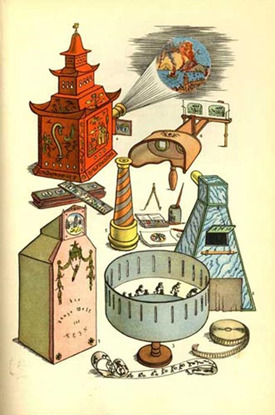
Lithograph by Alfred Mahlau from “Spielzeug, eine Bunte Fibel”, a german book from 1938 by Hans-Friedrich von Geist. The lithograph shows a Kaleidoscope, A Stereoscope, a Zoetrope, along with later film mediums. Source.
The 19th century was an era of vision, the exploration of it, the evolution of it, and the play of it. Within the century we see the concepts of vision evolve, from the simple exploration of tricks of the eye to the questioning of the credibility of it, alongside it we see these optical toys appearing as exploration of the concepts. The kaleidoscope appears in the early 19th century as an exploration of the interaction of the eye and light. The thaumatrope flips as a exploration of an illusionary sticking image of the eye. The phenakistoscope spins to look at how the interaction of the eye and light can create illusions of movement. The stereoscope appears as another exploration of an illusion the eye creates, being used to explore other regions and concepts. Finally, the Zoetrope and the Praxinoscope make their way in, becoming early concepts of animation by building off the concepts of the phenakistoscope, and enhancing the effect with more slits and mirrors.
While these toys may seem laughably simplistic to us, there is a reason things like yoyos, balls, and dolls are still so amazingly popular along with these very optical toys being recreated and sold. There is a joy in simplicity, there is joy exploring the human eye.
Farman, Jason. “The Forgotten Kaleidoscope Craze in Victorian England”. Atlas Obscura, November 9th, 2015. https://www.atlasobscura.com/articles/the-forgotten-kaleidoscope-craze-in-victorian-england
Greenslade, Thomas B. “Praxinoscopes”. Instruments for Natural Philosophy, Keyton College. http://physics.kenyon.edu/EarlyApparatus/Optical_Recreations/Praxinoscopes/Praxinoscopes.html
Gunning, Tom. “Hand and Eye: Excavating a New Technology of the Image in the Victorian Era” Victorian Studies, Vol. 54, No. 3, Indiana University Press, Spring 2012. Pgs. 499-501, 513.
Herbert, Stephen. “The Thaumatrope Revisited; or: "a round about way to turn'm green". The Wheel of Life, https://www.stephenherbert.co.uk/thaumatropeTEXT1.htm
Jacob, Carol. “Tate Painting and the Art of Stereoscopic Photography”. ‘Poor man’s picture gallery’: Victorian Art and Stereoscopic”. Tate, https://www.tate.org.uk/whats-on/tate-britain/display/bp-spotlight-poor-mans-picture-gallery-victorian-art-and-stereoscopic/essay
Kamar, Julie. “The Wheel Of The Devil - The History Of The Zoetrope From Ancient China To Pixar”. June 1st, 2012. Thalo, https://www.thalo.com/articles/view/343/the_wheel_of_the_devil_the_history_of_the
Thompson, Clive. “Stereographs Were the Original Virtual Reality”. Smithsonian Magazine, October 2017. https://www.smithsonianmag.com/innovation/sterographs-original-virtual-reality-180964771/
“A Short History of the Phenakistoscope” June 28, 2014. Juxtapoz: Art & Culture, https://www.juxtapoz.com/news/news/short-history-of-the-phenakistoscope/
“Phenakistoscopes (1833)”. The Public Domain Review, https://publicdomainreview.org/collection/phenakistoscopes-1833
9 notes
·
View notes
Text
How to choose pickups for your electric guitar - a kinda small beginner guide

An electric guitar's pickup is what sends the signal to your amplifier. The first pickups were used on guitars are "piezo" types, what means that they're just sending to the amp what it hears, not what you play. Now this type of pickups is obsolete and only used for acoustic-electric guitars or contact microphones. You can find them in some cheap instruments also because sometimes they simply replace the original ones to be able to sell it as an acoustic guitar with no need to put strings on it (as if people wanting to buy an acoustic guitar would want one without strings...).
The electric guitar's pickups are divided into several main groups: single coil or humbucking. Single coils are what you see mostly now, but lots of guitar brands still use humbuckers, what you can find most often in the "vintage styled" guitars or what most metalheads like to play because of their specific sound.
Piezos and most single coils are composed by magnets (the same as what is used to make transformers and speakers what is what you hear when they're working, not the voice coil which it's what makes them move). The magnets give a field what changes according they put next to your strings and every pickup has its own number of magnets what defines how will be its output signal. Every brand uses different types of magnets what'll change for sure their output signals.
Single coils have 2 basic types: P-90s pickups or Telecaster style ones called what what comes in mind is "soapbars". P-90s are longer and use a single magnet what gives them what we call "horseshoe" magnets what'll make the nearby field's to be smaller what opens their coils more when you play giving you a much hotter output signal. Telecaster style pickups have 2 or 3 magnets what makes the nearby field bigger and that way they're hotter than P-90s but not as hot as what humbuckers do, because their coils are very close together what reduces their output signal instead of increasing it like what happens with P-90s.
Humbuckers, invented by Gibson in 1954, were created for reducing noise caused by distortion what can be generated by overdriving the amplifier what is the main problem of single coils what also made them "hiss" what you can hear when they're overdriven. The sound that comes from every humbucker it's pretty similar what makes most professional players to love them and use them without thinking too much about their type because there isn't so many differences between their sounds what makes it easier for a guitar player to choose what he needs for his specific songs or setups.
There's 2 basic types of humbuckers: Seymour Duncan and Gibson (there are others but less important). When you see Gibson's pickups you'll see what the letters in the code mean while with Seymour Duncan you'll see how many magnets they have, what gives us different output signals. There are also what we call "vintage" and what we call "modern" what means that the vintage one's will have more bass what can give you a warmer sound what most metalheads don't like, while the modern ones will have more treble making them hotter what most blues players or jazz players won't like.
To help you with choosing what humbucker do you want to use I'll tell you what are the main differences between both of them: Gibson's pickups usually have an output signal which is pretty hot while Seymour Duncan ones' are usually not so hot what makes it perfect for metal players looking for their specific tone. But if your guitar has not enough room to put several magnets next to each, because it needs some wood what should be the other magnets what are close to them what makes Gibson pickups, with only one magnet what comes in mind, what is called what gives you what everybody wants for their guitar's sound which is a very clear and defined tone.
So how can you choose what humbucker do you need for your guitar? If you play metal, look out for Seymour Duncan pickups because they're perfect for it. But if you play blues I wouldn't advise choosing them since they have more treble what blues players don't like so much. If your music style varies from clean to overdriven stuff then there's no problem at all with using both types of pickups combined on one electric guitar what'll give you the best results ever!
We have what we call what what comes in mind is a three way switch what makes every pickup to be connected or not connected what'll give us 3 different sounds. The bridge pickup, what you can use for solos and leads what has the highest output signal, the middle one which is usually your clean tone and your neck one what gives a warmer sound but less output signal. So if you always want to have a very defined sound with no noise even when you play fast I don't recommend choosing more than 1 humbucker on any of your guitars because it'll make them "hiss" too much making it hard for your ears to listen what's going on while playing music.
One other thing that all pickups have in common is that they're what what we call what what isn't inside the plastic: what what what is exposed to air and what can get corroded.
Here are some of my favorite pickups that I want you to look out for when making your choice for an electric guitar pickup that fits with your tastes the best
• Duncan '59 Bridge Humbucker also known as Jazz Model
This pickup in detail: Made in USA Hot output signal 3-conductor cable 4-wire connection How much it costs? : $89 online
• Duncan Custom Custom Bridge Humbucker what what what is hotter than the Jazz Model what what what has an output signal even more "hotter". How much does costs? : $110 online
• Seymour Duncan '59 For Strat Bridge Humbucker what comes in with an even higher output signal, perfect for metal players. How much does it cost? : $105 online
• DiMarzio DP407 Tone Zone with Coil Tap what what makes it perfect for shredders and hard rock players what gives you a very clear tone in comparison to most of humbuckers out there today. How much does it cost? : $122 online
I hope this article helped you find out how magnetic pickups work and how to choose electric guitar's pickups for what music style you want to play what'll give you the tone that fits your needs best.
So what are you going to buy first? :)
0 notes
Text
Ampli, chitarre e... progetti?
Hey ya, blog!
Ci eravamo lasciati tanto tempo fa con gli aggiornamenti.. in questo torrido pomeriggio di agosto ci sono altri aggiornamenti!
Innanzitutto nel comparto chitarre abbiamo aumentato il parco:
Venduta la Schecter ho preso una PRS SE Standard 24 a cui ho aggiunto le meccaniche autobloccanti, i potenziometri lampshade USA, lo split push/push e un setup ottimale. Non mi aspettavo suonasse così bene e fosse così comoda... l’ho presa nell’elegantissima colorazione blu scuro, il mogano e le venature sono incredibili! Comodissima... Begotti docet!

Quasi nello stesso periodo ho cercato una chitarra che fosse color “ambra” e mi è capitata una Ibanez SA 250 che non mi sono lasciato sfuggire! Bellissima colorazione, molto comoda, interessante il sistema True DuoBucker!
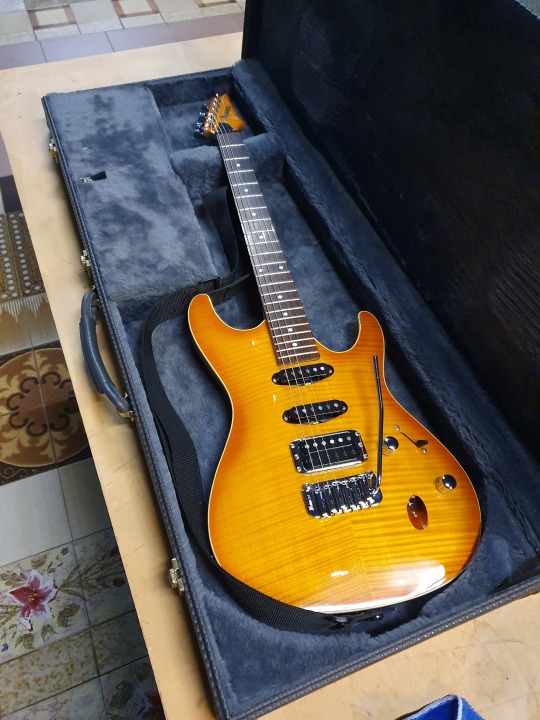
Certi amori non finiscono: fanno giri immensi e poi... ritornano! Mi sono pentito subito di aver venduto la Sterling JP60, avendo trovato lo stesso modello l’ho comprato, cambiato i pickup originali con la combo Crunch Lab/Liquifire che avevo sulla Premium (a cui ho messo la coppia Seymour Duncan Distortion/Jazz Neck e suona da DIO!) ed eccola, ben tornata a casa, comodissima chitalla Petrucciana! E che suono... assurda!

Alcune settimane fa ho realizzato un “sogno”: avrei sempre voluto una Fender Stratocaster bianca, sin dalla prima volta che ho imbracciato una chitarra... e infatti la pazzia ha preso il sopravvento! Ed eccoti qui, coi tuoi 22 tasti, il tuo ponte a 2 pivot, la tua americanicità e i tuoi pickups AlNiCo! Affiancata alle altre due bestiole!
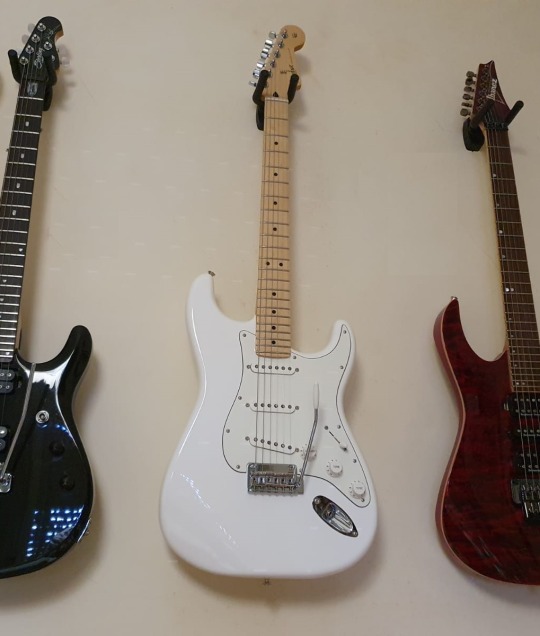

Amplificatori grandi e piccoli!
Ed ora passiamo al capitolo amplificatori: una curiosità, un pensiero, un’idea che diventa realtà! Hughes&Kettner TubeMeister 36! Testata valvolare moooolto interessante, riverbero, possibilità di utilizzo 36w, 18w, 5w e 1w, oltre che la modalità Red Box e l’uscita midi. Tre canali (clean, crunch, lead) e suoni valvolarissimi con le finali EL84! Oltre che la bellezza estetica, suona incredibilmente, ho settato la Helix proprio per utilizzarla al meglio con questa testata che, chissà, forse porterò qualche volta al posto della Engl ai concerti (mhh..)

Per curiosità ho preso da Amazon un Blackstar Fly 3, piccolissimo, dai suoni veramente validi (clean+drive+delay) e leggerissimo! Non so se lo terrò, però ne valeva la pena provarlo! Troppo carino!

Pedalboard!
Ho venduto la Boss GT-100 e preso quello che avevo in mente da tempo: un Pod Go con la sua borsa. Volevo qualcosa simile alla Helix per le prove, dato che il suono delle simulazioni è quello, stessi effetti etc. ovviamente con più limitazioni, mi trovo bene a fare le prove col gruppo (e anche a casa, collegata ai monitor Mackie nel mio “studio” con Scarlett 2i2 FocusRite e il MacBook Pro). Nelle prove ho simili configurazioni, movimenti, suoni e colori (dei led e del display) che ho con la sorella maggiore. Soddisfattissimo, un acquisto veramente veramente veramente valido! Che suoni!

Penso sia tutto! Un sacco di aggiornamenti musicali ma, concedetemelo uscendo dall’ambito musica, ho fatto un acquisto importante: Audi A1. Venduta la Fiesta, ho fatto questo grandissimo acquisto di cui vado fiero!

Ci sentiamo presto, blog non seguito! Magari, chissà, se vendendo qualcosa prenderò la Charvel DK24 che sto adocchiando da tanto tempo! Sperando vada tutto bene...
Rock on!
Andree
0 notes
Text
LEAK: Epiphone Adam Jones 'non-art' Silverburst Custom 2024
The Epiphone Epiphone Adam Jones ‘non-art’ Silverburst Custom Les Paul is coming. This time it has the correct shape headstock as well! Epiphone Adam Jones ‘non-art’ Silverburst Custom Essentially, this Epiphone Adam Jones ‘non-art’ Silverburst Les Paul Custom is everything that fans wanted. Without the Art Collection artwork on the rear of the guitar and with the correct Gibson-shaped headstock…

View On WordPress
#2024#Adam Jones#Art Collection#Epiphone#Epiphone Adam Jones &039;non-art&039; Silverburst Custom 2024#Epiphone ProBucker Custom humbucker#Epiphone Protector#Korin Faught#Les Paul Custom#Seymour Duncan#Seymour Duncan Distortion i#Silverburst#Sweetwater#Tool
1 note
·
View note
Text
Current Rig and other Gear 🎸
The gear I currently use to perform is: my 63’ Michael Kelly electric guitar, fitted with high output Seymour Duncan pickups. My guitar then runs into my MXR Super Badass Custom Overdrive pedal, which have set to clean up my muddy tone, and boost the signal for a better distorted sound. In regards to amplification, I use a Marshall G50RCD with custom loudspeaker, this amp produces beautiful clean tones as well as a decent drive channel which is complimented by my overdrive pedal.
TL;DR
Michael Kelly 1963 Electric Guitar
Marshall G50RCD Valve Amp
MXR Super Badass Custom Overdrive Pedal


0 notes
Video
youtube
Line 6 HX Stomp Demo - Synth Simulator Any Good? In this video, I explore the synth simulator ability of the Line 6 HX Stomp to see if it is any good. Pickups: Bridge: DiMarzio Super Distortion Humbucker Pickup - Black Neck: Seymour Duncan SH-1n '59 Model 4-Conductor Pickup - Black Neck Consider subscribing to my channel!: https://www.youtube.com/user/chadgarber?sub_confirmation=1 Recommended Guitar Lesson Playlists: ✅ Free Guitar Lessons Online - https://www.youtube.com/playlist?list=PLfkqslf5n04u_krUPQ6wtraqoXpKfSLfh ✅ Beginners Guitar Lessons - https://www.youtube.com/playlist?list=PLfkqslf5n04syuGgwfZZEZQk8FY47RnFw ✅ Cover Song Guitar Lessons - https://www.youtube.com/playlist?list=PLfkqslf5n04sFNjcweyaTlDmi3-HAaI7P ✅ Finger Strengthening Exercises for Guitar Players - https://www.youtube.com/playlist?list=PLfkqslf5n04v9RdpGtk4tKWMGL2LGStzr ✅ Lead Electric Guitar Lessons - https://www.youtube.com/playlist?list=PLfkqslf5n04u0f4a4NgDpA4xAiMw0lnS7 Recommended Cover and Original Music Playlists: ✅ Original Songs by Chad Garber (On All Instruments) - https://www.youtube.com/playlist?list=PLfkqslf5n04shdjjTtc3c6d1rkISjCsnJ ✅ Cover Songs by Chad Garber (On All Instruments) - https://www.youtube.com/playlist?list=PLfkqslf5n04sK4GEWyDwKt2MS3SfH0Eto Recommended Gear Review Playlists: ✅ Music Equipment Demos & Reviews - https://www.youtube.com/playlist?list=PL2BBB829896B66BDF ----------------------
0 notes
Photo

FOR SALE: $1,100 George Lynch Skull & Bones Mr. Scary guitar. Hand built & carved by X-Ray guitars in Michigan. Has a real Floyd Rose tremolo, Seymour Duncan Distortion pickup, Alder body, Maple neck & Ebony fingerboard. Comes with original case & certificate of authenticity. Plays great & sounds great. Has been played very little. Very cool guitar. I AM NOT INTERESTED IN TRADES If interested EMAIL me at [email protected] ________ #dokken #georgelynch #seymourduncanpickups #floydrose #mrscary #customguitar #customguitars #mrscaryguitar #guitarporn #georgelynch #georgelynchguitar #guitar #guitars #xrayguitars
#georgelynchguitar#xrayguitars#guitars#dokken#mrscary#customguitar#guitar#seymourduncanpickups#floydrose#mrscaryguitar#georgelynch#customguitars#guitarporn
30 notes
·
View notes
Text
Best Semi Hollow Body Electric Guitars Reviews
Semi-hollow body electric guitars are versatile instruments that you can play in a huge range of genres.
If you want to rock out hard and heavy, they deliver deeply resonant tones with plenty of low end oomph to make your hair stand up.
If you’re more of a softy, they can produce beautiful clean tones bordering on acoustic aesthetic that will make your soul soar.
And if you’re somewhere in the middle or looking to try your hand at every genre, semi hollow guitars are tonally balanced in a way that lets them fit nicely in nearly every musical style.
We’ve tried out the best of the best on the market to bring you this list of some of the greatest semi hollow guitars around.
For this list, I’m keeping things around my own budget, which as a man of rather average means, should encompass the price range that the typical player will find reasonable for a guitar of good quality.
Our Recommendation
You’ll see in the last and #7 spot the Dean Boca 12-string. It hits all the quality markers of a good semi hollow, but is too susceptible to warping and feedback to rank any higher on this list of the best.
Awarded the win, the best of the best semi hollows, is the Gretsch G2662T Streamliner.
We’ve raved on this guitar before, and personally I rave on Gretsch guitars a lot, because they’re solid, dependable, sound great, and are true classics in the semi hollow category.
The Top 7 Best Semi Hollow Body Electric Guitars – Overview
#7 Dean Boca 12-String
youtube
4/5 Star Rating
Specs
Body – Mahogany with Flamed Maple top
Neck – Maple
Fingerboard – Jatoba
Electronics – Dual DMT Design humbuckers
Pros
Beautiful Flamed Maple top adds brightness to the warm tone
12 strings for extreme chorus effect
Dependable Dean electronics
Cons
Can easily warp if kept in poor storage conditions
Review
This is the first 12 string semi hollow electric I’ve seen, and Dean did a great job of putting it together.
This Boca 12 String is an absolutely beautiful guitar, both in appearance and in tone, and it’s one I’d be happy to call my own.
12 strings on a semi hollow body guitar is rather unusual, and for good reason. Semi hollow electrics are often heavy in harmonics and overtones, and can be subject to feedback when played at high volumes.
In the Boca 12, the over-abundance of overtones is somewhat dampened by the maple neck, which is also the best would they could have chosen to prevent warping caused by the tension of 12 strings.
The DMT Design humbuckers do a good job of tamping down unwanted buzz and feedback, but you can still have a problem if you play at full volume.
Its mahogany body does what mahogany does, which is present a warm, earthy tone that is heavy in the bass and low midrange. If it weren’t for the maple, the subtleties of the 12 strings would be almost completely ignored, but this neck material brings out just enough brightness that you can value this guitar for what it was made for.
The Dean Boca 12 is great for blues and jazz, and can even hold up pretty well in some hard rock scenarios. However, I much prefer its tone clean over distored.
Despite having the hard, dense maple neck, you’ll still need to be careful about how you store this guitar, as 12 strings put excessive tension on the neck and can cause it to warp badly if subjected to high levels of humidity.
#6 Squier Affinity Starcaster
youtube
4/5 Star Rating
Specs
Body – Maple
Neck – Maple
Fingerboard – Maple
Electronics – Dual Squier Standard humbuckers
Pros
Bright, crystalline tone
Dual humbuckers cut down on the treble of the all-maple build
Comfortably contoured body shape
Cons
Overabundant high range
Review
Another unusual semi hollow body electric, we’re following up with the Squier Affinity Series Starcaster.
This is a really unique looking semi hollow guitar, following the body shape of the original 1976 Fender Starcasters and looking like a Stratocaster molded by Salvador Dali.
It’s an all-maple guitar, which in most cases would yield a tone that I find too flat and lacking in the low end. However, thanks to its semi hollow build and dual humbuckers, the low and mid ranges are boosted just enough to keep up with the glassy highs produced by maple.
Its pickups are the Squier Standard humbuckers, which are nothing special but do a good job of cutting back the buzz and putting forth a tone with enough power to let you rock out in most genres.
I’d recommend this guitar especially for jazz, as its clean tone is super articulate and there aren’t a lot of overtones. Overdriven, it can sound a bit harsh, but with a little bit of distortion it performs well.
If you upgrade the pickups in the Squier Starcaster, you can have a really nice and interesting semi hollow electric in your collection. Otherwise, you have a decent guitar for practicing your chops.
#5 Epiphone ES-335 PRO
youtube
4.25/5 Star Rating
Specs
Body – Maple
Neck – Mahogany
Fingerboard – Rosewood
Electronics – Dual Alnico Classic Pro
Pros
Vintage looks and tones in a modern re-issue
Classic ES sound nicely replicated by Alnico Classic Pro humbuckers
Gibson style SlimTaper “D” neck for fast licks and firm chords
Cons
Wiring can become loose if jolted too hard
Review
Gibson debuted the original ES back in the 1950s, and now Epiphone has crafted this modern remake to bring you a vintage sound at an affordable price. You can hear a full history of this famous Gibson model here.
The ES-335 PRO is so close to the original Gibson that it’s amazing they sell it at such a low cost.
The woods are virtually identical, with a mahogany neck and rosewood fingerboard set in to a maple body with a maple center block.
Sound-wise, this tonewood combo exudes great balance in every range, with poppy highs and cool lows and a middle range that sinks just low enough for vocals to fill the scoop.
It has two humbuckers designed in the same fashion as those that appeared in Gibson’s original ES-335, sending forth a tone that is reminiscent of classic rock and mid-century blues hits.
The Epiphone ES-335 PRO could be a near-perfect semi-hollow guitar if it were more dependably soldered. Unfortunately, due to Epiphone’s streamlined production process, the wires in the pickups are often easily bumped loose, causing crackle and static and sometimes entire loss of sound.
A quick trip to the guitar tech can remedy this issue should it arise, but as long as you take care not to knock your guitar too hard on anything (no smashing over heads), this shouldn’t be much of a problem.
#4 D’Angelico Premier SS
youtube
4.25/5 Star Rating
Specs
Body – Maple
Neck – Maple
Fingerboard – Ovangkol
Electronics – Neck: Seymour Duncan HB-102N humbucker Bridge: Seymour Duncan HB-101B humbucker
Pros
High quality humbuckers deliver powerful semi-hollow tone
Comfortable C-shaped neck
All-maple build for highly articulated riffs and chords
Cons
Unconventional ovangkol fretboard
Review
This guitar is more on the expensive side for this list, but that’s due to the great pickups it comes with.
The D’Angelico Premier SS is a semi hollow electric in an all-maple build, similar to the Squier we looked at earlier.
If it weren’t for its pickups, it wouldn’t be on this list at all, but these are high quality Seymour Duncan humbuckers that perfectly transmit the guitar’s vibrations.
Since it is completely maple, you don’t get a lot of low end depth, but there’s enough resonance from the hollow wings that it doesn’t sound too tinny and sterile.
It’s a great jazz guitar, and if your amp has enough boost to fill out your low end it can do well in rock genres as well.
It would be a place or two higher in this review had D’Angelico opted for a higher quality fingerboard. There’s nothing particularly wrong with ovangkol, but I much prefer the smoothness of rosewood or the responsiveness of ebony over the rather standard feel of this wood.
If there’s no chance you’ll upgrade your pickups at any time and you have the cash, this is probably the best choice for you.
#3 Hagstrom VIK-SHB Viking
youtube
4.75/5 Star Rating
Specs
Body – Maple
Neck – Canadian Hard Maple
Fingerboard – Resinator
Electronics – Dual Hagstrom HJ-50 humbuckers
Pros
Great tone at an affordable price
Dependable construction for years of playing pleasure
Versatile for many genres
Cons
Synthetic fingerboard material
Review
I have to start this review by saying I don’t know what Hagstrom’s secret is. Theoretically, this should be lower on the list, as I’m not super fond of all maple guitars or synthetic materials.
However, the Hagstrom Viking is an amazing sounding, super fun to play semi hollow body.
It’s probably their pickups, which though not a well-known brand, are bold and punchy without being over the top in hotness.
Hagstrom started as an accordion manufacturer, which isn’t exactly a skill I’d think would transfer to guitar craftsmanship, but whatever it is, they do a great job.
The VIK-SHB is the first guitar on this list I’d recommend for any genre. It’s not too bright, it’s not too warm; it’s in the Goldilocks zone of semi-hollow perfection.
You can crank the gain to max and play metal, or keep it clean for super funky progressions, or go somewhere in the middle for rockabilly and blues.
I had a hard time moving on from this guitar, and am seriously thinking of adding it to my personal collection.
#2 Ibanez Artcore AS53TKF
youtube
4.75/5 Star Rating
Specs
Body – Sapele
Neck – Nyatoh
Fingerboard – Laurel
Electronics – Dual Infinity R Ceramic humbuckers
Pros
Unbeatable price for a quality semi hollow electric
Infinity R humbuckers good enough for small shows
Fast playing Ibanez neck profile
Cons
No traditional tonewoods
Review
Mostly, the Ibanez AS53 is in the number 2 spot for its price, which is about the lowest I’ve seen for a decent semi hollow body electric guitar.
I surprised myself by liking this guitar as much as I did. Normally, when I see that a guitar is made entirely from non-standard tonewoods, I won’t even consider it for a best of list. But, Ibanez is a big name with a lot of experience in making high quality low cost instruments, so I gave the AS53 a closer look.
In an acoustic, sapele is a fine enough wood for the back and sides, but I wouldn’t want it as my top wood. With the AS53, it’s a bit different, and seems to really put out a nice, complex tone.
It’s not a huge sounding guitar, but it does have enough force and proud enough voice that I’d play it at small gigs.
For practicing in home, yes, it’s a perfect little semi hollow. It has an undersized body which is really comfortable to hold, and a Ibanez custom Artcore AS neck profile that is sleek, slim, and speedy to play on.
Although its pickups aren’t remarkable, they’re not bad either, and I could see myself having a great time owning the Ibanez AS53.
#1 Gretsch G2622T Streamliner
youtube
5/5 Star Rating
Specs
Body – Maple
Neck – Nato
Fingerboard – Laurel
Electronics – BroadTron BT-2S humbuckers
Pros
Great traditional sound
High-standard Gretsch design
Bigsby vibrato tailpiece for funky tonal warping
Cons
None
Review
This isn’t the first time that we’ve awarded Gretsch first place. This same guitar is also the number 1 spot in our review of the best semi hollow body guitars for the money.
If this wasn’t a list trying to keep things within a moderate budget, most of the top spots would go to various Gretsch models, as there’s hardly any competition for them when it comes to top quality semi hollow body guitars. They’re simply one of the best, with several decades of expertise in this category.
In the Gretsch G2622T Streamliner, this expertise is apparent in the pairing of a treble-rich maple body with the warming properties of a nato neck, topped up with Gretsch’s house-brand BroadTron humbucking pickups.
The resulting tone is super versatile and can be used in blues, jazz, rock, country, pop, funk… you name it, you can probably manage it with the G2622T.
It’s the only guitar in this review with a vibrato tailpiece, which is really a shame. More semi hollow guitars should have this feature, because a little whammy goes a long way to having a fun, experimental jam session. You can just get a lot more out of your sound with this addition. It’s one of the main reasons this Gretsch is our winner in this list.
The BroadTron pickups are no joke. They’re hot, but not too hot, and really pronounce the resonance of this semi hollow with perfect boost and clarity.
It’s a joy to play, and sounds great clean or distorted.
So, once again Gretsch, my hat’s off to you for beating out the rest in the semi hollow body electric guitar category.
For more of this great brand, check out our full review of the Gretsch G5420T.
Buyer’s Guide
What Are Semi Hollow Body Electric Guitars Good For?
For the most part, these are great guitars for jazz and blues. They’re earthy sounding instruments, with a lot of resonance due to the hollow wings and usually a fairly prominent mid range.
Clean, their applications extend in just about every musical direction. You can hear them in country, pop, bluegrass, folk, jazz, blues, rockabilly, rock’n’roll, and so on and so forth.
Distorted, they make exceptional guitars for jam bands, dirty blues, rockabilly, and rock from hard to soft.
You can see them played by a wide array of artists, from Lady Gaga to Paul McCartney to Dan Auerbach of The Black Keys.
They’re extremely versatile, and probably the only exception to their capabilities is heavy metal. Though, if you’re daring, you might even venture into this territory with a semi hollow body electric guitar.
Who Should Buy a Semi Hollow Body Electric Guitar?
Normally, I’d say these are best for players with at least a little bit of experience.
If you’re just starting out, I’d recommend you think about what you want to play more, acoustic or electric, then pick one and get good at it.
Semi hollow body electric guitars have a more niche kind of sound and artist following, and are best if you really know what tone you’re aiming for.
This is hard to be sure of when you’re just beginning to play, and if you’re anything like me, you’ll vacillate over the first couple years between wanting to be the heaviest metalhead that’s ever been to only wanting to play beautiful fingerpicked folk progressions.
If you do have experience, semi hollow body guitars are great for blues and jazz, considered maybe to be the best guitar for these genres. They fit nicely into the mix of these types of bands, and are only the dominant voice when you want them to be.
Want to know some other great guitars for blues? We’ve got you covered in this review.
Of course, I can’t tell you not to buy one if you’re a beginner, but I truly think you’d be better off learning the basics on a guitar that swings either full hollow or solid body.
What’s the Difference Between a Semi Hollow Body and a Hollow Body?
In tone, semi hollow body electric guitars are less resonant than full hollow body guitars and offer less in the way of overtones and harmonics. They’re a more “closed” sound, more similar to solid body electrics than to acoustics.
Hollow body guitars have a more “open” sound, being much more resonant, more full of harmonics and overtones, and so similar to acoustics that they are often called semi-acoustic guitars.
These differences are attributable to their variations in construction.
A hollow body electric guitar started simply as an acoustic guitar with a pickup added. Over the years they became a category all their own, with slimmer body profiles, f-holes rather than round sound holes, different bracing patterns, and different choice tonewoods.
Today, they stand apart as a separate type of guitar altogether and are used largely in country-style music genres.
Semi hollow body electric guitars were designed to decrease the issue of feedback that is inherent with full hollow body guitars. They are usually constructed with a solid center block attached to two hollow wings.
Sometimes, they are simply solid body guitars that have had some of their wood routed out and covered with a solid top, giving them the appearance of a solid body electric while actually being semi hollow.
This semi hollow construction reduces feedback, while at the same time reducing resonance. They are often much slimmer than hollow body guitars, and can weigh a bit more due to this solid center block.
Interested to learn more about hollow body guitars? Check out our review of some great hollow bodies here.
What’s the Difference Between a Semi Hollow Body Electric and a Solid Body Guitar?
This question’s answer is basically in the asking.
A semi hollow body electric guitar is very similar to a solid body electric guitar; it just has less wood in certain spots.
Sometimes, they can look identical. This is the case if the semi hollow body guitar is of the type that has wood routed from its body and then covered with a solid top. It creates the appearance of a solid body guitar, while having less weight and more resonance than a solid body electric.
Solid body guitars, on the other hand, are exactly what they sound like. Their body is a solid piece of wood, with no air pockets, no holes for resonance, no gaps and spaces in which air can vibrate. Their sound is the most “closed”, and unamplified you’ll get almost no tone from them.
Solid body guitars can do a lot of the same as semi hollow electrics, but are less well-suited for genres that favor a resonant guitar tone such as country, blues, and jazz.
Solid body sounding more like your style? We’ve reviewed the best value electric guitars here.
The Final Word
If you’ve made up your mind that a semi hollow body is the right choice for you, more power to you.
There are a lot of great options out there, and I’ve barely scratched the surface with these seven more affordable models.
If none of them really speak to you, keep searching, though you’ll have a hard time finding better models of comparable cost.
When we’re talking the best guitars, we have to take cost into mind and consider what the average player will be able and willing to spend.
This cost to quality ratio turns up some good choices, and I’m confident that from among those we have chosen the best semi hollow body electric guitars in production.
Whether you go with the all-traditional Gretsch or the modernized Dean 12-string, these are guitars of great quality that will bring you joy for as many years as you play guitar.
If semi hollow doesn’t sound like your thing, keep tuned in to us at BeginnerGuitar.pro for in-depth looks at the best of the best guitars.
The post Best Semi Hollow Body Electric Guitars Reviews appeared first on Beginnerguitar.
from WordPress https://beginnerguitar.pro/best-semi-hollow-body-guitars
0 notes
Video
This is a 1977 Gibson Black Beauty @gibsoncustom that belongs to an awesome friend of mine. It wasn’t in real working order so I had my tech load a @seymourduncanpickups Custom Shop pickup in the bridge & brought it back to life with a vengeance! This is seriously a gorgeous beautiful beast of a guitar! It’s strung up with @drstrings & I’m using @sinisterguitarpicks so I can rock your face off! I’m using a Seymour Duncan #dirtydeeddistortion for my distortion sound. #gibson #gibsonlespaul #gibsonguitars #lespaul #quilter #quilterlabs #tone #toneblock #seymourduncan #seymourduncanpickups #sinister #guitar #picks #sinisterguitarpicks #sinisterguitarpicksartist #rocknrollindustriesmagazine #rocknrollindustries #rocknrollindustriesmag #vintage https://www.instagram.com/p/B38C5ffBjRX/?igshid=1aqp0eimhwvr0
#dirtydeeddistortion#gibson#gibsonlespaul#gibsonguitars#lespaul#quilter#quilterlabs#tone#toneblock#seymourduncan#seymourduncanpickups#sinister#guitar#picks#sinisterguitarpicks#sinisterguitarpicksartist#rocknrollindustriesmagazine#rocknrollindustries#rocknrollindustriesmag#vintage
0 notes
Photo

1983 Kramer USA Baretta Matching Hocky Stick headstock ⠀ ⠀ https://buff.ly/2z44UGu⠀ ⠀ 1983 Blond Baretta (Holy Grail) with matching Hockystick headstock, SA…WEET !!⠀ Super Clean – 100% Original Body and Neck and hardware, no repairs, original frets! no refret, no alterations!!⠀ ⠀ 1983 serial number of C3678-⠀ ⠀ She has a R5 nut width, 1 3/4″ and Original (Made by Schaller in Germany for Kramer) Double locking Floyd Rose Tremolo.⠀ ⠀ Black Gotoh 90 degree tuners, Barrel output jack.⠀ ⠀ ⠀ ⠀ Best part of this Beatch >> she sports a super resonant Fretboard / Maple Neck (features an oil finish) ⠀ ⠀ The neck Is KILLER >> smooth as SILK and oh so PHAT ! !⠀ ⠀ 1983 “Holy Grail” Baretta features:⠀ ⠀ Reverse Zebra Schaller Humbucker (Golden 50) These pickups have a very hot, bright sound with a nice touch of bottom end. ⠀ I have owned over 200 early Baretta’s and the Schaller (Golden 50) in my experience have a very “BROWN” sound & is a MOST KILLER Humbucker,⠀ The Golden 50 pickups are hotter than the Seymour Duncan Custom installed in later baretta’s⠀ ⠀ 1983 Baretta body made by SPORTS, it has interesting characteristics like a small route in the backside trem cavity for better spring movement, along with a sharp arm scarf.. ⠀ Floyd Rose and hardware on this early Baretta has more of a Flat black finish than the later models which were more glossy.⠀ ⠀ The guitar is original except for the Schaller (Golden 50 .. Needs to be hooked up!) which I found on Fleabay after I bought her and replaced the Dimarzio Super Distortion . ⠀ ⠀ ⠀ ⠀ Real SWEET and the Maple body is as heavy as hell !⠀ ⠀ ⠀ Frets have tiny amour of wear and the one piece maple neck/headstock is straight as an arrow. ⠀ I have the string height set super low for optimize tapping, Intonation is dead on! ⠀ You can catch harmonics anywhere on the Phat Fretboard- ⠀ There is some scuffing and some dents on the finish front and back(see pics). ⠀ ⠀ #guitar #guitars #guitarist #Guitarists #guitarra #guitarstrings #guitarlove #guitarlover #guitarlovers #guitarsdaily #GuitarCollection #forsale #guitarsofinstagram #bestguitarsite #electricguitar #usedguitar #usedguitars #electricguitars #kramerguitar #kramerguitar
#guitarstrings#guitarlover#kramerguitar#usedguitar#guitar#guitarist#guitars#guitarlovers#forsale#guitarlove#guitarsofinstagram#guitarra#guitarists#guitarcollection#usedguitars#guitarsdaily#electricguitars#bestguitarsite#electricguitar
0 notes
Text
Aggiornamenti sul Gear
Salve blog-non-seguito!
Tra lavoro, studio e pandemia da Covid-19 non ho un minuto di tempo ma è da troppo che non aggiorno Tumblr!
Partiamo subito con gli aggiornamenti sulla strumentazione, dall’ampli per studio alla pedaliera per le prove.
Alla fine ho scelto di prendere lo Spider V della Line 6: perfetto, bellissimi suoni, tantissimi effetti e simulazioni, looper, metronomo e aux in. Ha dei volumi esagerati e va benissimo per studio.. bisognerebbe prendere un footswitch anche per lui..
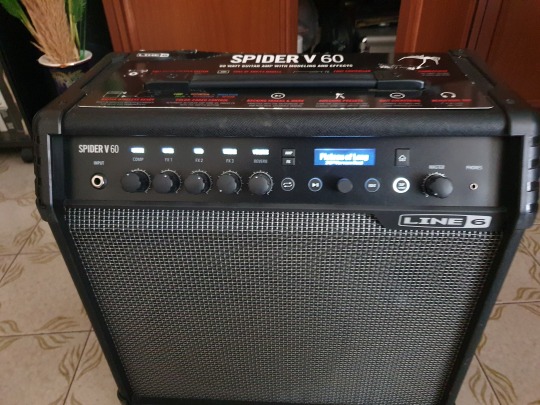


Dato che per le prove portarmi ogni volta la Helix + la Palmer80 + il FreqOut + la JamMan XT + pedale espressione EHX era troppo (per peso e soprattutto per valore economico) ho optato per prendere una pedaliera e la scelta è tornata “al passato”, la Boss GT-100 e anche la custodia! La uso come uso la Helix, a singoli pedalini e devo dire che ha un suono niente male! Ha tutto quello che mi serve, dalle distorsioni ai delay, al Whammy e Feedbacker e tutti gli effetti che uso nelle nuove canzoni (stay tuned, Dioniso!). Mi piace che abbia pure il looper e il metronomo, inoltre i due display con le icone sono davvero fighi!
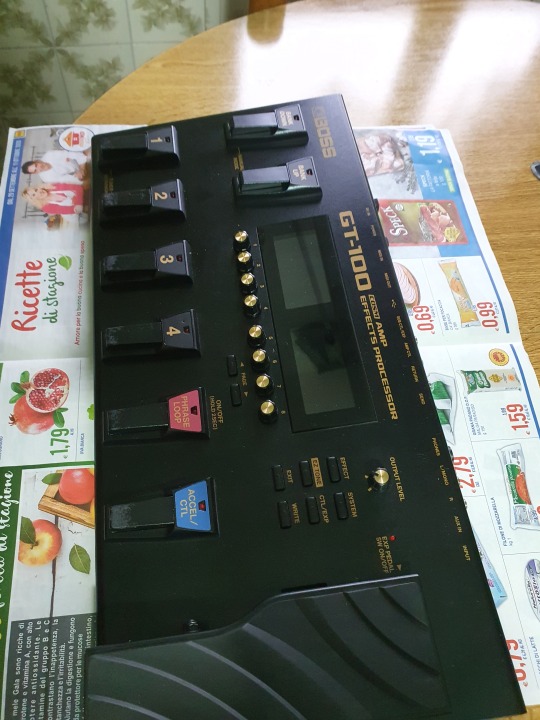

Aggiornamento delle chitarre:
La chitarra per le prove
Ho venduto la Telecaster e... ho preso una Schecter Diamon 6 Extreme FR. Ero titubante.. la Schecter mi è sempre piaciuta (marchio usato anche da Synyster) e stavo cercando una chitarra che avesse un marchio differente da quella di sempre (oltre la Jackson) e una forma particolare: bella, blu, con binding, Floyd, H/H. I pickup non erano dei migliori, allora ho modificato quelli della Jackson (davvero bel suono), ho rimosso il logo, li ho smontati, tramutati in pickup splittabili, ricerati e via. PERFETTI! Il manico mi spaventava, è grassotto ma ha un radius da 14″ che lo rende scorrevole.. certo non è la Jackson o l’Ibanez ma davvero comodo! Questa chitarra è quella che “sacrifico” per le prove.
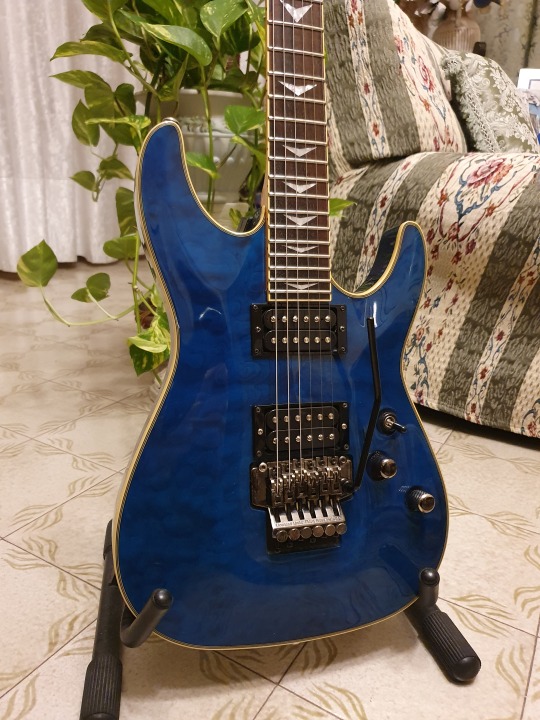
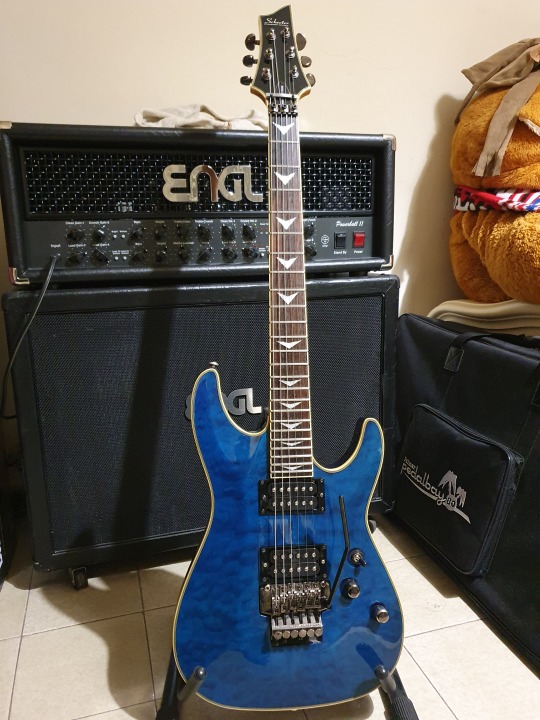
La chitarra metallara!
Eccola qui, ho optato per una Jackson SLX, finalmente una chitarra “tutta nera” (con venature trasparenti, elegantissima) e configurazione H/H. Dato che ha molto spazio nel vano dell’elettronica ho cercato due pickup EMG (85 e 81) e l’ho resa “attiva”, suono davvero molto metal, ma anche nei puliti non mi dispiace! La bellezza di questa Jackson è che ha il compound radius che va da 12″ a 16″, veramente spettacolare. Il floyd è morbidissimo e perfetto, non si scorda mai! Molto metallara e cattiva!
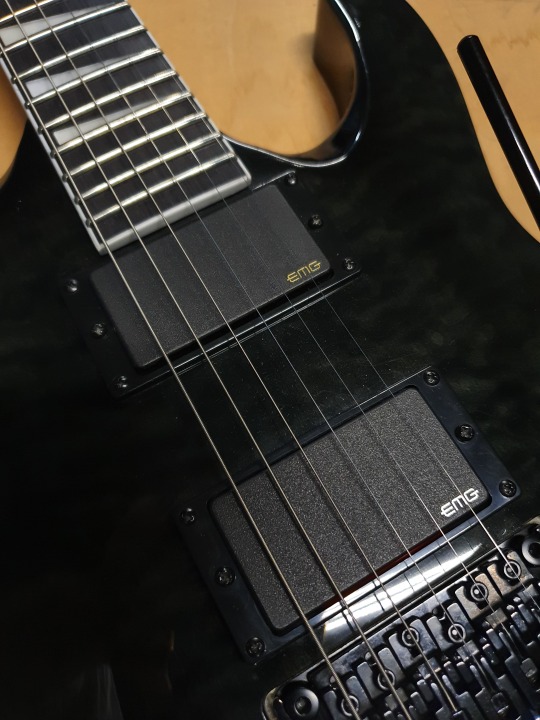
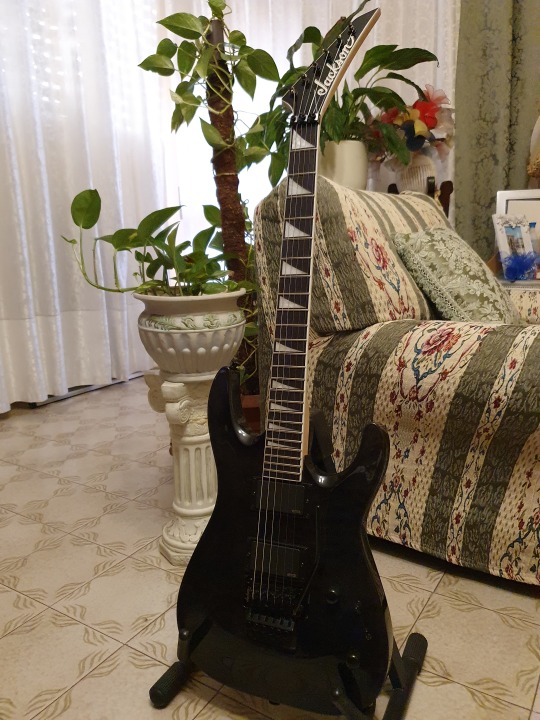
Sound rock, migliorato ampiamente!
Ho cambiato i pickup all’Epiphone Les Paul Custom con due artigianali, beh, che dire? Tutto un altro mondo! Peccato non siano splittabili (ho evitato di smontarli e togliere la cover), altrimenti sarebbe fantastica!
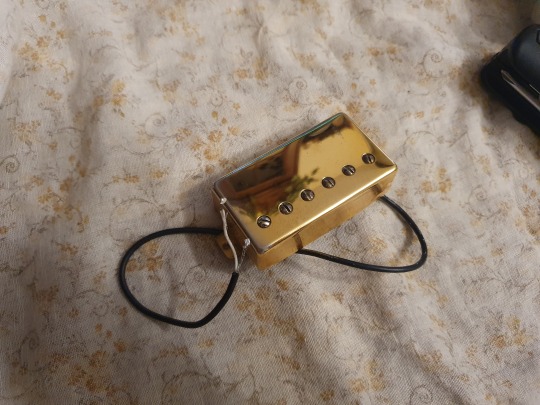
H/H in formato H/S/H? Petrucci Style!
Ho venduto i Seymour Duncan (tutti e 3) per sostituirli nell’Ibanez RG Premium con “un ritorno al passato”: DiMarzio Crunch Lab e Liquifire + il centrale “escluso”: ho acquistato dalla Korea uno speciale (anzi due!) switch a 5 vie, sull’orma di Petrucci, che mi permette di avere le seguenti combinazioni:

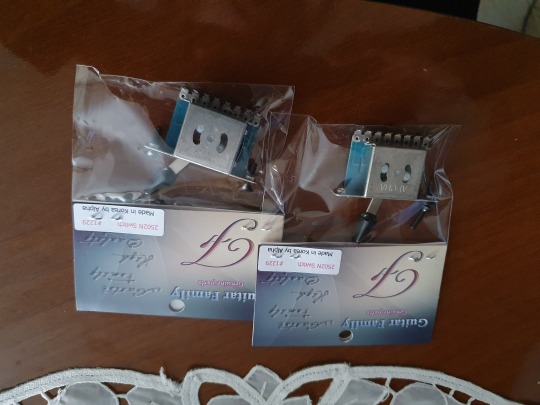
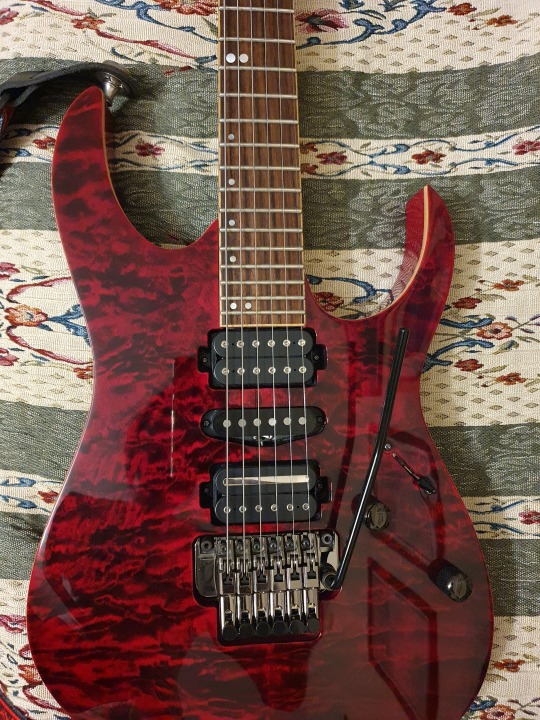

Bellissimo poter avere in posizione 5 il neck in parallelo, suono da single coil ma non basso di volume. Ho inoltre modificato la circuiteria per fare in modo di avere un push/pull e splittare sia il bridge che il neck quando voglio. Stesso lavoro l’ho fatto sulla Prestige (escludendo il mid Air Norton) ma lasciandola esteticamente H/S/H. Non escludo di acquistare un battipenna H/H per la Prestige, mi piacerebbe in alluminio spazzolato ma non si trova... quindi opterò per quello nero (vedremo).
Il ritorno a casa
Dulcis in fundo son riuscito a riportare a casa la Fender Showmaster. Era amore, è tornato amore! Un po’ “disastrata” ma niente che non si possa risolvere. Avevo deciso di metterci il Seymour Duncan JB nel ponte ma l’ho venduto, quindi ha un Seymour Duncan SSL-1 nel neck, un Fender vintage coil nel mid e un Fender Einforcer Humbucker al bridge (che ho reso splittabile). Comodissima e bellissima, bentornata a casa!
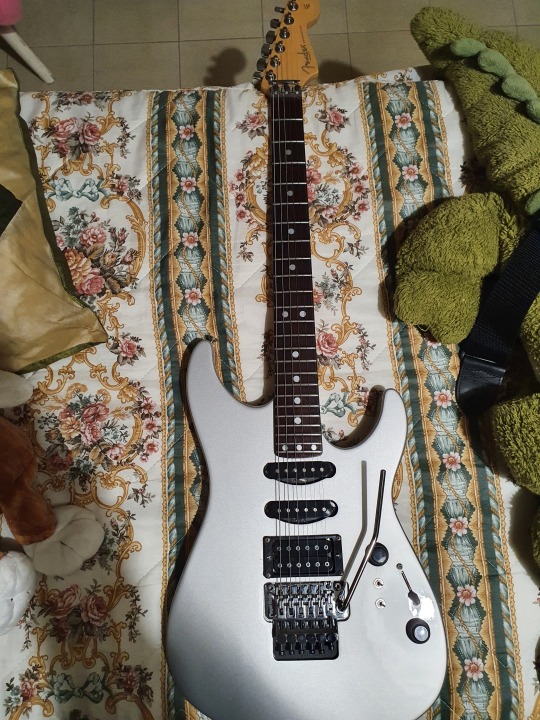
Unite the Seven!
Eccole qui, tutte e 7, ho comprato uno stand dove averle a portata di mano, già con leva e tracolla! Bellissime anche agli occhi!

Acquisti futuri:
Oltre corde, plettri e forse qualche cavo ho una mezza idea di riportarmi la Fender Stratocaster alla gloria di un tempo. Credo di ricomprare le sellette (ormai arrugginite) e, forse, un set di pickup Wilkinson (un tempo ero fissato col ponte di questa marca) di cui ho letto recensioni davvero fighe. Ma non escludo di lasciare i pickup originali Fender (tutti U.S.A.)!
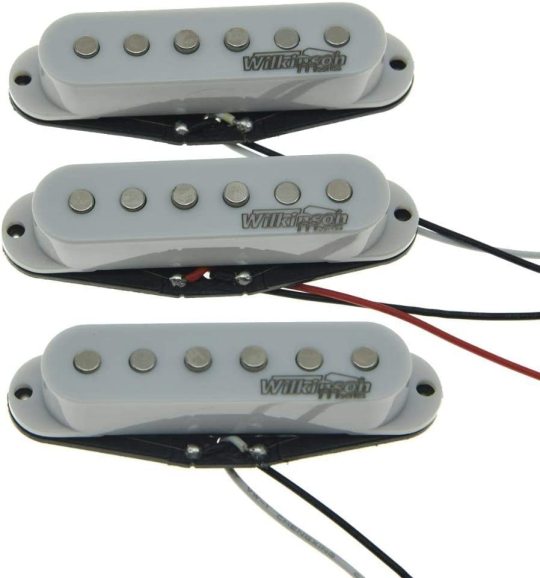
Vorrei ricomprare un Seymour Duncan SH-5 Custom come ai bei tempi, per la Showmaster e magari anche un altro single coil sempre Seymour Duncan per il mid. L’ontano + i Seymour Duncan sono stratosferici.

Vorrei prendere due pickup “seri” anche per la Schecter e sono orientato verso i Seymour Duncan Distortion ma il neck non si trova facilmente. Dicono siano perfetti per il genere che piace a me... vedremo un attimo! Mi piacerebbero!

Devo prendere un footswitch per lo Spider V e credo sarà uno di questi, dipende dal prezzo:


Utili per cambiare preset e usare il looper da pedale quando studio o, chissà, magari pure in live in piccoli luoghi (Covid-19 permettendo)
Vi ringrazio per l’attenzione, credo che sia tutto! A presto!
Rock on!
Andree
0 notes
Video
youtube
Awesome Line 6 HX Stomp Preset for electro-harmonix Mel 9 Pedal In this video, I improvise with a preset that I made from the Line 6 HX Stomp to allow the Mel9 guitar pedal to go through effect loop to create some very beautiful sounds. Pickups: Bridge: DiMarzio Super Distortion Humbucker Pickup - Black Neck: Seymour Duncan SH-1n '59 Model 4-Conductor Pickup - Black Neck Consider subscribing to my channel!: https://www.youtube.com/user/chadgarber?sub_confirmation=1 Recommended Guitar Lesson Playlists: ✅ Free Guitar Lessons Online - https://www.youtube.com/playlist?list=PLfkqslf5n04u_krUPQ6wtraqoXpKfSLfh ✅ Beginners Guitar Lessons - https://www.youtube.com/playlist?list=PLfkqslf5n04syuGgwfZZEZQk8FY47RnFw ✅ Cover Song Guitar Lessons - https://www.youtube.com/playlist?list=PLfkqslf5n04sFNjcweyaTlDmi3-HAaI7P ✅ Finger Strengthening Exercises for Guitar Players - https://www.youtube.com/playlist?list=PLfkqslf5n04v9RdpGtk4tKWMGL2LGStzr ✅ Lead Electric Guitar Lessons - https://www.youtube.com/playlist?list=PLfkqslf5n04u0f4a4NgDpA4xAiMw0lnS7 Recommended Cover and Original Music Playlists: ✅ Original Songs by Chad Garber (On All Instruments) - https://www.youtube.com/playlist?list=PLfkqslf5n04shdjjTtc3c6d1rkISjCsnJ ✅ Cover Songs by Chad Garber (On All Instruments) - https://www.youtube.com/playlist?list=PLfkqslf5n04sK4GEWyDwKt2MS3SfH0Eto Recommended Gear Review Playlists: ✅ Music Equipment Demos & Reviews - https://www.youtube.com/playlist?list=PL2BBB829896B66BDF ----------------------
0 notes